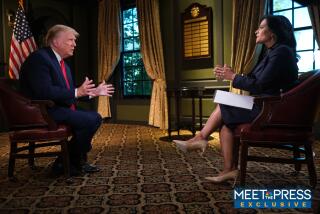Dole Limits His Exposure to Media and GOP Rivals
- Share via
WASHINGTON — Sen. Bob Dole’s campaign advisors, trying to ride a lead in the polls and wary of blunders like those that buried his 1988 presidential bid, have been methodically limiting the candidate’s appearances with GOP rivals and his exposure to the national press corps, say campaign observers and political strategists.
Although the recent surge by rival Steve Forbes may force the Dole team to reevaluate, so far the Kansas senator’s campaign has avoided several opportunities for joint appearances with other candidates and made relatively few appearances in early caucus and primary states.
At the same time, his campaign is keeping its distance from the media--putting off requests for interviews, often waiting days to return phone calls and abandoning the traditional practice of allowing the press to travel to campaign stops with leading candidates.
To some extent, Dole’s ability to scoot out of Washington for campaign appearances has been hindered by his critical role in the on-again, off-again federal budget talks and by bad winter weather.
“We’d like to be out there with you guys,” Nelson Warfield, the campaign’s press secretary, told a group of reporters who surrounded him during a recent whistle-stop in Des Moines. “But we’re very busy back in Washington and can’t be everywhere we want to be.”
That also serves the campaign’s purpose, however. Dole staff members readily admit to positioning him as the uncrowned GOP nominee who is already battling President Clinton--not party rivals--for the White House.
“He doesn’t want to devalue his status as the front-runner,” said Roger Stone, a GOP political advisor. “As long as he’s the front-runner he can command media attention any time he wants it. If the front-runner speaks, it will be covered, so he can choose to speak only when he has something to say.”
And Tuesday night, Dole assured himself of coverage by exercising his prerogative as Senate majority leader and delivering his party’s response to Clinton’s State of the Union speech.
Forbes has sought to counter the Dole strategy by spending millions of his own dollars for an advertising blitz and by extensive personal campaigning. There are some signs that the strategy is working. Polls show Forbes gaining ground in New Hampshire and Iowa, which could force Dole to adjust.
“The problem with the front-runner’s strategy is that when it falls apart, it’s hard to get it back,” said James Carville, a Democratic strategist who helped engineer Clinton’s 1992 presidential victory.
The Dole strategy is rooted in bitter experience. Looming over this campaign are memories of his failed presidential bid in 1988, when he was unable to capitalize on early success and his candidacy floundered amid reports of staff disorganization and conflict.
This time, political analysts agree that Dole seems to have a more cohesive staff in place, and he is allowing his advisors to make more decisions than they did eight years ago. That includes following a game plan that makes avoiding damage a central goal--and that has become wildly unpopular with other candidates.
“We wish he would come out and play more,” said a Forbes campaign advisor. “It would make our job of showing the contrast between us and them easier.”
A frustrated advisor to Sen. Phil Gramm (R-Texas) accused Dole of hiding from his opponents and reducing interest in the campaign. “He’s trying to turn campaign events into nonevents by not showing up,” the advisor said.
Dole advisors make no apologies for this approach.
“Our message is, ‘Why go shopping for Brand X candidate, when you’ve got the front-runner challenging Bill Clinton already?’ ” said Warfield.
Dole, long known as one of the sharpest wits in Washington, suffered in 1988 from his off-the-cuff remarks. Although many of his asides were humorous, others seemed mean-spirited.
His staff knows it has to guard against the candidate “popping off at the slightest provocation,” Carville said. For that reason, “it’s wise for his staff to look for the most controlled environment for him to engage his opponents,” he said.
Reporters, meanwhile, are complaining about their inability to reach top Dole staff members or to travel with the campaign. The experience has built an unusually wide gulf between the media and a candidate who is known on Capitol Hill as open and cordial with the press.
Unlike Forbes and other GOP contenders, the Dole campaign has had no press traveling closely with the candidate at most of his campaign appearances. With Dole, the media are left to scramble for their own transportation, which means reporters do not hobnob with campaign officials or the candidate en route to events.
In the opinion of some analysts, the reduced contact with reporters makes sense, particularly for a candidate as well known as Dole.
“There are not many mysteries about Bob Dole,” said Thomas Mann, a political analyst at the Brookings Institution, a Washington think tank. “He’s a commodity that has been around for decades. It’s not important in Dole’s case whether there is a planeload of journalists flying around with him. I can’t get worked up over this.”
More to Read
Get the L.A. Times Politics newsletter
Deeply reported insights into legislation, politics and policy from Sacramento, Washington and beyond. In your inbox twice per week.
You may occasionally receive promotional content from the Los Angeles Times.








